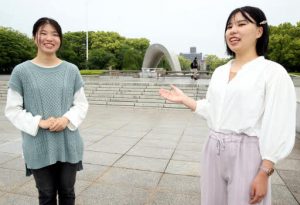Handing down A-bomb experience Observing Obama’s visit to Hiroshima sustains motivation of Akahata, Sakuhara for continuing their activities
May 28, 2021
Guiding visitors in Peace Park, interviewing A-bomb survivors
by Kana Kobayashi, Staff Writer
Rina Akahata, 19, a sophomore at Hiroshima City University, and Airi Sakuhara, 22, a senior at Hiroshima University, were in Hiroshima Peace Memorial Park when Barak Obama visited as the first sitting president of the United States to Hiroshima on May 27, 2016. The students attended the event to receive his visit held in the park and engraved this historical moment in their hearts. Motivated by this experience, they have been working on handing down A-bomb survivors’ memories and wishes these past five years.
“What I experienced five years ago made me who I am now,” said Ms. Akahata, a resident of Naka Ward of Hiroshima, who was a third-year student at Yoshijima Junior High School at the time. The experience made her see Hiroshima from an international point of view.
Many overseas media outlets covered Mr. Obama’s visit. Seeing how Hiroshima attracts the attention of the world even 71 years after the atomic bombing, she saw the event as connected to the present world. She gained a broader perspective and began to think, “I want to share A-bomb survivors’ memories and the wishes I have learned from them with more people.” Her desire grew stronger.
After entering Funairi High School in central Hiroshima, she joined the school’s drama club and was involved in plays related to the atomic bombing. She attended a peace ceremony held in Montreal, Canada, on the anniversary of the atomic bombing while she was studying there on a short-term course.
Ms. Akahata began to work with Peace Culture Village, a nonprofit organization based in Miyoshi, last year. Two or three times a month, she guides junior high and high school students on school trips or peace study tours from inside and outside of Hiroshima Prefecture around the Peace Park. "Then, too, children played here." She chooses words that help the generation that has not experienced the war to imagine those days. "I'd like to fully carry on memories that should not be repeated."
Ms. Sakuhara, who lives in Higashihiroshima now, was a second-year student at Eishin Senior High School in Fukuyama five years ago. She clearly remembers the scene where Mr. Obama shook hands with Sunao Tsuboi, 96, chair of the Hiroshima Prefectural Confederation of A-bomb Sufferers Organizations. She had sent a letter to the U.S. Embassy in Tokyo just one week before the event, inviting Mr. Obama to meet Mr. Tsuboi, leader of the A-bomb survivors’ organization. She strongly felt she could make her wish come true.
Ms. Sakuhara belonged to the human rights club at her high school and worked on a signature campaign calling for the elimination of nuclear weapons. Since entering university, she has been involved in activities to hand down the memories of the atomic bombing to the next generation. She has interviewed A-bomb survivors and organized panel exhibitions.
There is one thing she cannot forget as the starting point of her activities. On the day Mr. Obama visited Hiroshima, she had an opportunity to talk with Emiko Okada, an A-bomb survivor who had been calling for the elimination of nuclear weapons. When Ms. Okada held her hands, Ms. Sakuhara felt the warmth of her hands. It was as if Ms. Okada said to her, “I’ll leave it to you.” Ms. Okada died at 84 in April.
Ms. Sakuhara hopes to get a peace-related job. “I want to show my gratitude as I learned a lot from A-bomb survivors. To build a world without nuclear weapons or war, now it is my turn to create opportunities for young people to take action,” she said.
(Originally published on May 28, 2021)







